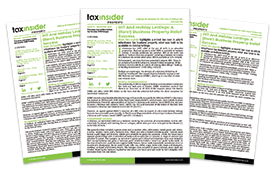Before you go, sign up to our free tax saving email course. Get 7 top property tax saving strategies in your email inbox that will help you save thousands in tax. Unsubscribe any time.
|
The expression ‘putting someone on the property deeds’ is commonly used to describe changing the legal ownership of a property, such as an individual’s home. ‘Putting someone on the property deeds’ often involves giving the dwelling, or an interest in it, to a spouse (or civil partner) or close family member. There could be several reasons for doing so from a tax perspective. This article focuses on inheritance tax (IHT) issues. Who owns what?For IHT purposes, a person’s estate comprises all the property to which they are beneficially entitled. English law recognises that property may be owned either legally or beneficially (nb different rules apply in Scotland). An individual may be the legal and beneficial owner of a property, although not necessarily both; it is the individual’s beneficial interest that matters in an IHT context. HMRC guidance indicates that an express written trust is (subject to certain limited exceptions) conclusive evidence of beneficial ownership, such as a common form of conveyance to two persons as beneficial joint tenants (see HMRC’s Inheritance Tax manual at IHTM15044; this guidance applies to England, Wales and Northern Ireland, but not Scotland). In cases of dispute over beneficial ownership (e.g. if the property deeds do not also establish the beneficial interest in the land), HMRC may seek evidence such as:
Gifts with reservationHowever, even if HMRC is satisfied that putting someone else on the property deeds has transferred legal and beneficial ownership, it is not necessarily the end of the story from an IHT perspective. Anti-avoidance provisions for ‘gifts with reservation’ (FA 1986, ss 102-102C; Sch 20) can make the gift of an interest in property ineffective for IHT purposes in certain circumstances. Example: Gift with reservationCyril is 78 years old and a widower. His house is worth approximately £600,000, and he has savings and investments worth £500,000. In 2012, he transferred an equal share of the property to his niece Doris, who lives elsewhere. Cyril continues occupying the property without paying Doris a full market rent for his continued occupation of her interest in the property. He assumes that by giving 50% of his home to Doris and having survived seven years, there will be an IHT saving on his death. Unfortunately, as things stand Cyril will be treated as the owner of the whole property for IHT purposes on his death, as the transfer of a 50% interest is a gift with reservation of benefit, due to his continued occupation rent-free. Practical tipPutting someone on the property deeds broadly involves changing the registered ownership of the property with the land registry. The legal process is beyond the scope of this article, but general guidance on transferring the ownership of property is available from the Gov.UK website (tinyurl.com/Gov-Trf-Prop-Own). For guidance on severing a joint tenancy in favour of a tenancy-in-common, see: tinyurl.com/Gov-JT-TIC. Professional assistance is generally recommended. This is a sample article from the monthly Property Tax Insider magazine. Go here to get your first free issue of Property Tax Insider. |


 Tax Articles
Tax Articles
 Mark McLaughlin looks at inheritance tax issues of ‘putting someone on the deeds’ of an individual’s home.
Mark McLaughlin looks at inheritance tax issues of ‘putting someone on the deeds’ of an individual’s home.